Day 1 of a 3-day long weekend of Autumn Migration tours today. The easterly winds we have been enjoying for the last couple of weeks are continuing, though only for a day or so more. That means there are still some great rarities from Siberia to catch up with – it was going to be a busy day! Our first destination was Wells Woods. There has been at least one Olive-backed Pipit here for the last few days, although it has been very flighty and elusive at times. Still, we thought we would give it a go and try to see it.
As we walked in from the car park, we could hear Bramblings calling and a couple of small groups flew back over our heads. Then a bigger flock of finches came out of the birches, about 40-50 strong. From their calls, they seemed to be mostly Redpolls – there have been a growing number in the trees here in recent days and there were lots more arriving yesterday, mostly Mealy Redpolls. Unfortunately, these didn’t stop and we watched them fly away to the east, over the car park.
A flock of Siskin were more amenable – we could see them landing in the bushes and several then dropped down to the puddles on the path ahead of us to drink.
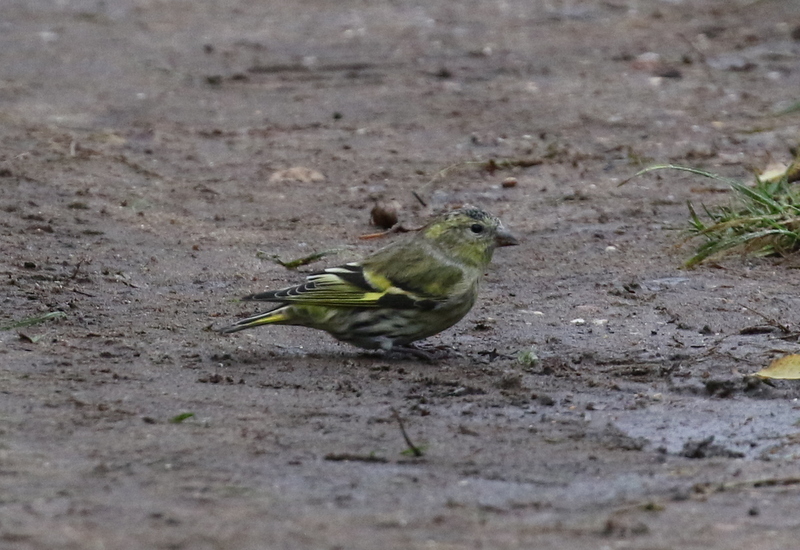 Siskin – coming down to drink on the path this morning
Siskin – coming down to drink on the path this morning
We cut in through the trees, around the area where the Olive-backed Pipit had been originally, but it seems to have been disturbed from here now by the crowds. There were fewer thrushes than recent days, but still plenty of Goldcrests in the birches and loads of Robins everywhere we looked – the vast majority are migrants escaping from northern Europe for the winter and stopping here to feed on their way south.
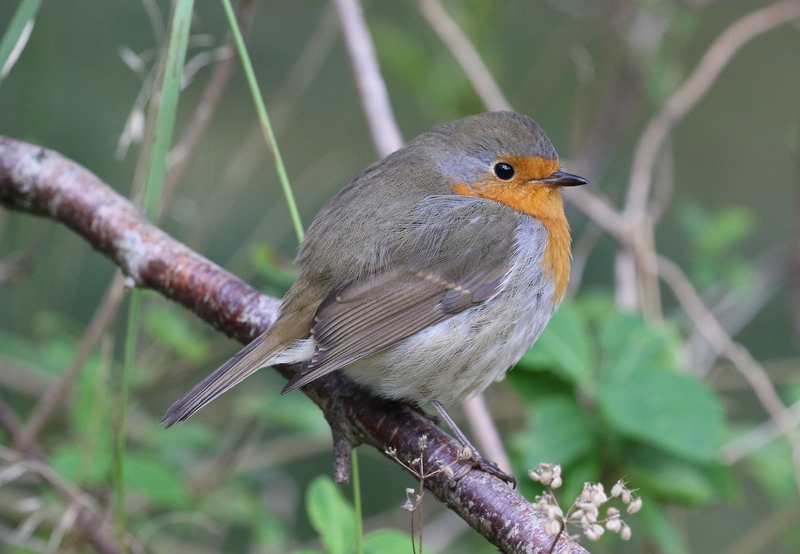 Robin – some of the northern migrants are very tame!
Robin – some of the northern migrants are very tame!
News came through that the Olive-backed Pipit was in the north side of the pines, where it had been at times yesterday, so we made our way quickly over there. When we arrived, there were lots of people milling around but no one seemed to know where it was. We walked quietly through the trees, checking out the old dune hollows where there is grass and small trees, and it didn’t take us long to find it. The Olive-backed Pipit was down on the ground under a young holm oak, but it was hard to see and it crept up the bank and out of view behind the foliage.
Unfortunately, our attentions drew the crowds over and we lost the Olive-backed Pipit. As we tried to follow it, with various people encroaching from different directions, it kept flushing. We could see it fly and hear it call, but then it vanished altogether. We decided to leave it in peace and try again later, once the crowds had dispersed.
While we were looking for the pipit, a Pallas’s Warbler had been reported over by the drinking pool, so we made our way over that way. When we got there, there was no sign of it but we did manage to ascertain that it was with a flock of Long-tailed Tits – so the challenge was to find the tits!
We continued on west, but the deciduous trees beside the path seemed rather quiet, despite the fact that the wind was lighter today. We did see a variety of raptors – a Common Buzzard flew low out of the trees, a Marsh Harrier quartered the fields to the south, a Sparrowhawk came over the tops of the pines and we were alerted to a Peregrine way overhead by its loud calls. There were lots of Jays too, carrying acorns off to bury them somewhere eminently forgettable!
A loud ‘tsooeet’ from an oak tree right next to us alerted us to a Yellow-browed Warbler. We could see it flicking around in the top, above our heads, but we got better views when it dropped down into a small birch tree. We could see its pale supercilium and double wing bar.
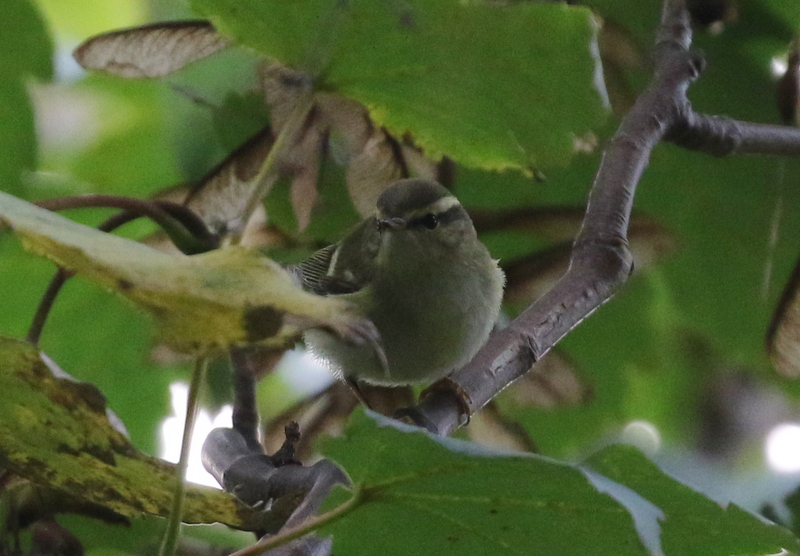 Yellow-browed Warbler – calling by the path
Yellow-browed Warbler – calling by the path
Walking on a little further, we finally heard Long-tailed Tits calling and cut into the trees to try to see them. But they disappeared into some pines and our attempts to catch them coming out the other side proved mostly fruitless. While we waited for them, we did see a Treecreeper climbing up a young oak, and watched a Great Spotted Woodpecker excavating a hole in a dead birch stump, pulling out beak-fulls of woodchips and scattering them below.
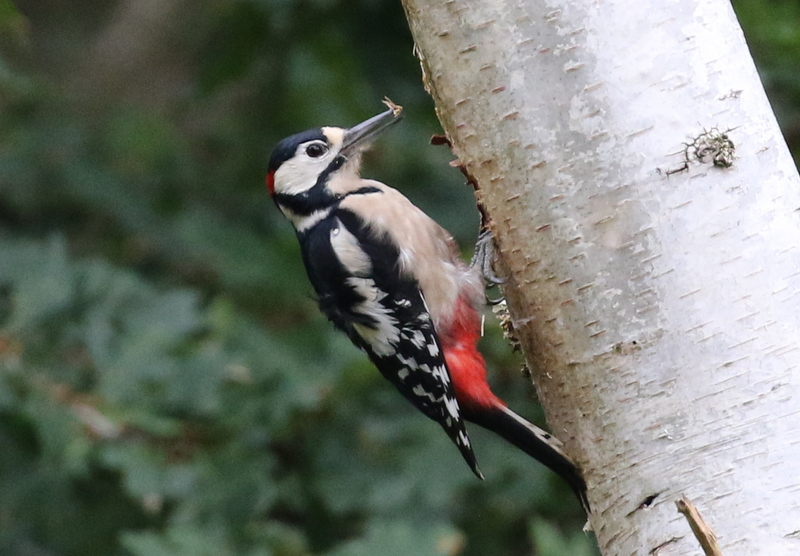 Great Spotted Woodpecker – excavating in a birch stump
Great Spotted Woodpecker – excavating in a birch stump
It seemed possible that the tit flock had made its way past us back towards the drinking pool, so we returned to the main path and started making our way back. Almost back there, we heard Long-tailed Tits again and made our way back into the trees. Almost immediately, we spotted a Firecrest flitting around in a small briar just in front of us, before it flew back up into the pines.
The tits seemed to be dropping out of the pines, and several came down into the small deciduous trees and undergrowth in front of us. After watching them for a minute or so, we had a tantalising glimpse of a warbler, but it disappeared before we could see it properly. Frustrating, but it felt like we might have the right flock this time. As the Long-tailed Tits started to make their way towards the path, we cut through and positioned ourselves in their path, in an open area with some lovely small deciduous trees in front of us.
The positioning worked perfectly! Just as we had hoped, the Pallas’s Warbler appeared in one of the oaks and we were treated to great views of it as it fluttered between the branches. We could see its yellow supercilium, brighter yellow at the front than the comparatively inappropriately named Yellow-browed Warbler we had seen earlier. The Pallas’s Warbler also had an extra stripe, a yellow central crown stripe, and when it hovered to pick insects off the leaves we could see it lemon yellow rump patch.
 Pallas’s Warbler – our favourite warbler!
Pallas’s Warbler – our favourite warbler!
Pallas’s Warbler is an annual visitor here, blown off course on its was south, typically just in small numbers at this time of year. They breed in southern Siberia and winter in China and SE Asia, so this one was a long way from home. With all the stripes and the lemon yellow rump, they are always a great favourite. A fantastic bird to see! As the tit flock continued on east, the Pallas’s Warbler flew off with them. We followed the flock to the drinking pool, but it didn’t stop. We did get great views of several Goldcrests and a Chiffchaff coming down to bathe.
We had bumped into some other birders before we found the tits who told us that they had just flushed an Olive-backed Pipit from south of the main path (in an area near where one had been reported yesterday). The one we had seen earlier had still not been relocated, and it was not far away as the Olive-backed Pipit flies, but it would have to be mobile to be the same one. We had a look where they had seen it but there was no sign and we were told it may have flown back north. We went back to where we had seen the Olive-backed Pipit earlier, but there was no sign of it there either.
Having had a quick look around the Dell, we decided to check out the path beside the caravan park. However, we had not got very far when another birder emerged from the trees talking on his mobile and told us his mate was watching the Olive-backed Pipit back behind the drinking pool. We hot-footed it round there only to find his mate had walked off and the pipit had flown up into the trees and been lost again. There were a few people still milling round but looking lost again. Frustrating.
The area looked promising – open mature pines, long grass below, and some scattered younger trees, meaning plenty of cover – perfect for an Olive-backed Pipit. So we circled round to the back of the grass and started walking very quietly along the furthest edge. Some movement in the grass caught our attention and there were not one, but two Olive-backed Pipits together!
Thankfully one of the Olive-backed Pipits stopped in the grass and turned to look at us, so we could get everyone onto it. The birds then made their way a bit further back, out of view, but circling round again the other side and we watched one flit up onto a dead branch lying underneath a young holm oak. This time we all got a great view of it as it perched there, pumping its tail up and down.
 Olive-backed Pipit – a photo from yesterday (when it was quieter)
Olive-backed Pipit – a photo from yesterday (when it was quieter)
Olive-backed Pipits can be very secretive and skulking so it was great to finally see one so well. This is another mostly Siberian species, although its breeding range spreads just into NE European Russia, and it normally winters in S Asia. After that, we made our way back to the car for a very well-earned lunch. It had certainly been a productive morning in the Woods.
After lunch, we climbed up over the seawall and made our way down to the lifeboat station to scan the harbour. There were several Brent Geese down in the harbour channel and a nice selection of waders out on the mud – lots of Oystercatchers, a single Black-tailed Godwit in with a group of Bar-tailed Godwits and Redshank, several Curlew, a couple of small flocks of Knot and, further over, a scattering of Grey Plover, Ringed Plover, Dunlin and a Turnstone.
The highlight here was the aerial battle between a juvenile Peregrine and a Ringed Plover. We first spotted them out over the mudflats across the other side of the harbour channel. The Peregrine was in quick pursuit, but every time it got close, the Ringed Plover turned sharply, much tighter than the Peregrine could turn, and opened up the gap again. Several times the Ringed Plover tried to escape by gaining height, but the Peregrine powered up higher. They were very evenly matched – it was just a question of which one would tire first.
The chase went on for ages – an adult would probably have given up much earlier, but this young Peregrine was either inexperienced or just very hungry. We lost sight of them round behind the lifeboat station but the next thing we knew they appeared again flying fast and low over the water just below us, flushing all the geese and roosting waders. When they disappeared from view again, the Peregrine must have finally given up because the next thing it appeared from round the lifeboat station only a few metres away from us!
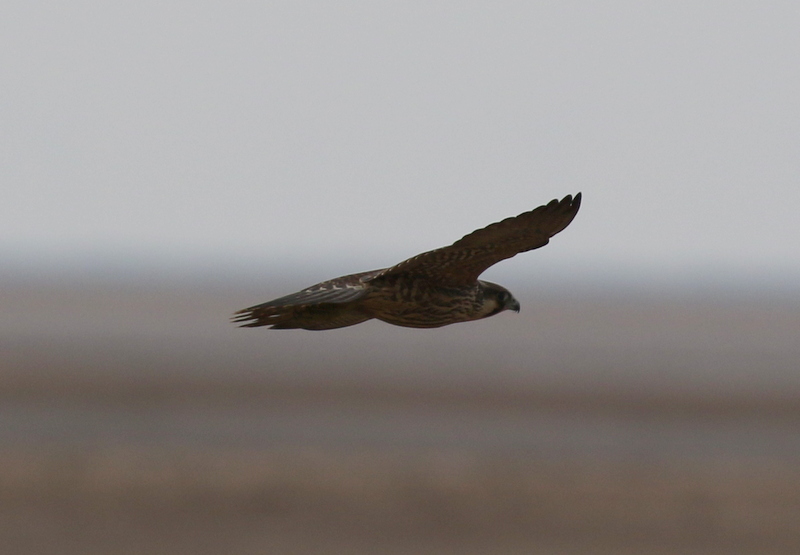 Peregrine – exhausted after chasing after a Ringed Plover, unsuccessfully
Peregrine – exhausted after chasing after a Ringed Plover, unsuccessfully
The Peregrine tried to land on one of the groyne posts not far from us, but thought better of it, so flew a short distance across the harbour channel and landed on a mudbank just the other side. We had a great view of it through the scope.
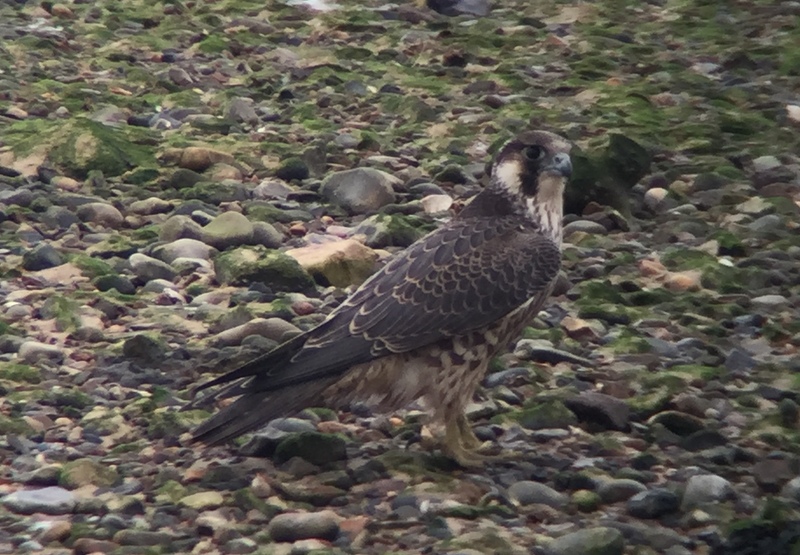 Peregrine – taking a breather after the fruitless chase
Peregrine – taking a breather after the fruitless chase
Our final destination for the day was Warham Greens. As we made our way down along the middle track, a small flock of Golden Plover flew over calling. A Blackcap flew across the track and we could hear Goldcrests in the hedge. There were still a few Blackbirds and thrushes in the bushes and, as we got down towards the end of the track, we heard a Ring Ouzel chacking from deep inside, although we couldn’t see it.
From out on the coastal path, we could see several flocks of Brent Geese out on the saltmarsh. Several bright white Little Egrets stood out against the dark vegetation. A couple of Marsh Harriers quartered the marshes in the distance. We made our way west to the pit where we could hear a Brambling, but couldn’t see it in the bushes.
There had been a Radde’s Warbler on Garden Drove earlier in the morning, but when we arrived there had been no sign of it for several hours. We had a quick look in the copse at the end, which was a bit exposed to the wind. There seemed to be more birds in the hedges along the track, and we quickly found the Yellow-browed Warbler, which flew across out of the taller trees and landed in a low hawthorn briefly.
We walked slowly up the track to the concrete pad and back down again. We did see a few Chiffchaffs and several Robins. And plenty of Goldcrests in the trees – amazing to think that these tiny birds, weighing less than a 20p piece, have made it all the way across the North Sea.
 Goldcrest – there are still lots in the trees along the coast
Goldcrest – there are still lots in the trees along the coast
With no sign of anything more exciting on Garden Drove, we decided to check out the hedgeline to the west, towards Wells. As we walked along the coastal path, flocks of finches got up from the edge of the field and flew up into the hedge. There were loads and loads of Bramblings, at least 100, probably a lot more, as well as Chaffinches, Goldfinches, Greenfinches, a few Linnets and a single Reed Bunting.
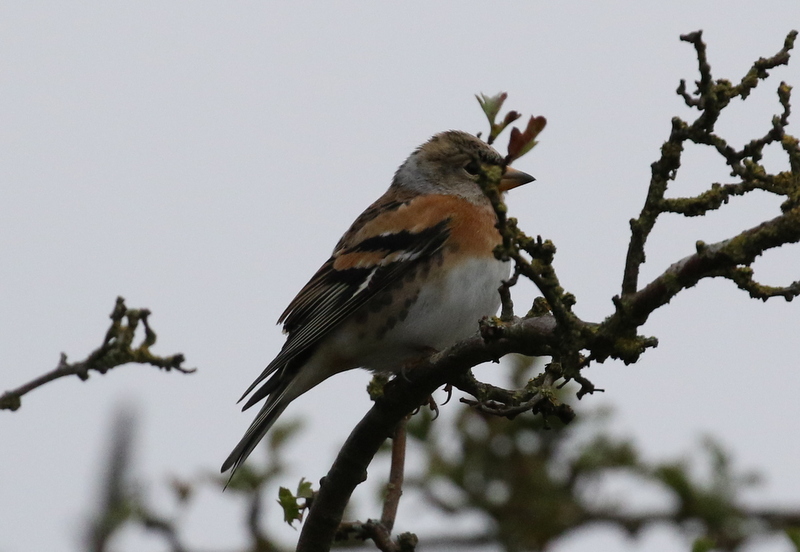 Brambling – there were loads in the fields this afternoon
Brambling – there were loads in the fields this afternoon
We stopped by one field which was planted with a seed mix and 20-30 Bramblings flew up into the hedge beside us, calling away. They have all arrived from Scandinavia in the last few days and have stopped to feed in the fields here. As we were admiring them, a small falcon flew fast towards us along the top of the hedge, scattering all the birds. It was a Merlin – it saw us at the last minute and turned away, flying off across the field the other side of the hedge towards the saltmarsh.
Then it was time to start making our way back. We scanned the saltmarsh on the way, seeing three Marsh Harriers now quartering in the distance. As we walked back along the middle track almost back to the car, a Merlin flew high east ahead of us – possibly a different bird returning to roost. It had been a tiring day, but a great one with some great birds.
















